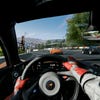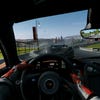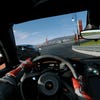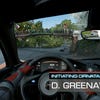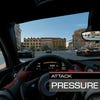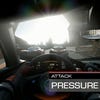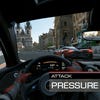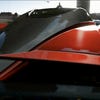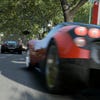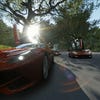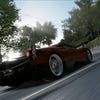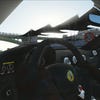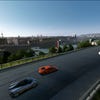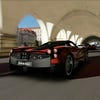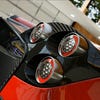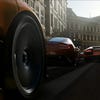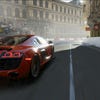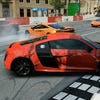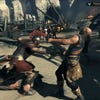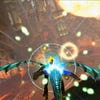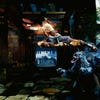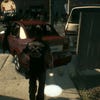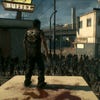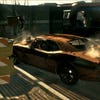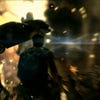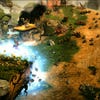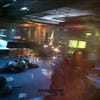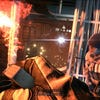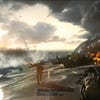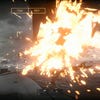Digital Foundry: Hands-on with Xbox One
Welcome to the next level.
Microsoft has a credibility problem. Xbox One launches in less than six months and yet its E3 press conference featured visibly poor performing software and a bunch of games actually running on PC-based surrogate hardware. We're told that these computers are either "target hardware" or "debug environments" but debate still surrounds the technological make-up of this kit - photos from E3 have emerged showing watercooled CPUs with Nvidia GeForce hardware, a world apart from production Xbox One silicon. We have reports of games crashing to Hewlett Packard branded desktops, stories of crashed game executables being terminated from the Windows Task Manager, and a conference reveal replete with the groan-inducing chicanery of "in-engine" footage and CG trailers.
Suffice to say, it's somewhat dismaying and very concerning that the majority of Xbox One games we saw at E3 were not actually running on console hardware, to the point where we were wondering whether the title of this article was somewhat disingenuous. We couldn't help but flash back to E3 2005, where key games were running on PowerPC Macintosh-based Xbox 360 dev kits (some of them overclocked, to boot). Coming out of E3, it's difficult to avoid the sense that Microsoft is not as prepared for its upcoming launch as it should be, especially in comparison to Sony, which was able to show all of its titles running on actual PlayStation hardware. It's a shame because beyond the glitches, tearing and poor performance of many of the games, it's our contention that Microsoft has a pretty strong launch line-up here.
And yes, there were some games that were - categorically, without a shadow of a doubt - running on Xbox One hardware. It'll come as little surprise to learn that first party software was more likely to be showcased running on the new console, with Turn 10's Forza Motorsport 5 the most high profile title we saw that was visibly operating on the actual unit.
Forza Motorsport 5
Our first hands-on features some classic Forza action with one track and a selection of six cars - we went with the legendary McLaren P1. The course itself features a misty riverside start which leads through a grove of cherry-blossoms and then out to an overview of a distant Prague city centre. As always the architecture looks fantastic, and every square inch looks exquisitely tooled in its replication of the real thing.
The generational leap brings with it a brand new graphics engine, taking advantage of a physical materials system. This means light scatters more realistically across not just the exterior curvature of cars, but also on more complex textured details like the lacing on cockpit interiors, or grills on the vehicle's rear.
A full 1080p resolution is in evidence here, and there's no compromise made to alpha transparency effects such as smoke when painting tyre marks across the floor - a known compromise on Xbox 360 editions of the franchise. On-site analysis is always difficult but it looks like a post-process approach to anti-aliasing is in effect here, evidenced by a light shimmer on metallic grills and chrome details. While post-AA can be rather ugly on current-gen console, our experience with PC suggests that a lot of the ugly side-effects of the tech are radically diminished with a higher resolution.
Downsides are few and far between; there's "pop-out" in the rear-view mirror while set to cockpit view, where pieces of the world disappear abruptly after passing a certain point. It's hard to spot in action once in the town itself, but it's obvious for the first minute of the race. The cockpit looks incredible, and reflections play a huge part in bringing this interior to life. The driver's hands are faintly mirrored in front window panel, alongside the rest of the dashboard. There's also a hugely effective use of lens flare/HDR from the sun as you drive between the town's archways, and while physics are sparing on non-car objects, you can collide with blue track barriers which bobble across the floor.
"Running at a nigh-on flawless 1080p60, Forza Motorsport 5 was undoubtedly the gameplay and technical highlight of Xbox One at this year's E3."
Welcome visual touches include mud splatter which collects on the fender and bonnet, plus more detailed destruction physics - there are pre-baked (but very high detail) scratched paint textures that swap in to achieve part of the effect, but those hoping for true context-sensitive damage are likely to be disappointed.
The promised rate of visual feedback is 60fps, and it holds true to precisely that. The game appears v-synced on just about every race we saw, but we did notice one person experiencing terrible tearing - likely because he was playing using a different viewpoint. We took the very same demo booth and had no such problems from cockpit view. Reflections in the rear-view mirror, plus those on the car exterior and passing shop windows, update at essentially half the rate (30fps) of the rest of the game - an effect that was dynamic in nature on Forza 4, returning to full-rate when the rendering budget permitted.
The Forza 5 demo was also noteworthy for its usage of the new force feedback triggers, with every slight nudge of the accelerator or brakes sending a satisfying mini-jolt directly to each index finger. Besides this, the control setup is standard fare for a Forza game, and we experienced no appreciable latency with the wired pad. The minimised dead zone also helped for light steering nudges, but it's safe to say that the improvement is much more radical for Sony's new Dual Shock 4 controller and its racing equivalent to Forza 5 - DriveClub.
Ryse: Son of Rome
Microsoft/Crytek's game has evolved away from the Kinect-based Xbox 360 game we saw at E3 2011, reappearing this year as a God of War-style hack and slash game. Our hands-on involves a short five minute demo that is once again categorically running on Xbox One hardware. Unlike Crytek's previous games, gameplay is engineered for third person action, showing essentially the same content as the conference demo. This takes us from the Normandy Landing-style beach battle, where the goal is to destroy and breach the tower ahead with a phalanx, to a siege on top of the stronghold where the aim is to launch a catapult. After dispatching barbarians in close-range combat, you round out each fight with a brutal QTE finisher - of which we're promised between 80-100 variations as we progress through the full product.
According to nearby staff, Ryse is a native 1080p game and the underlying tech is dubbed the "new CryEngine". Bearing in mind that both Crysis 2 and its sequel ran on CryEngine 3, we wondered whether Ryse may be running on a further evolved version of the tech - alas the attendants wouldn't be drawn on the provenance of the game's underpinnings. It's a technically sound game as you can expect, with many of the stock CryEngine 3 effects in play: we have full-screen and per-object motion blur, plus impressive fire effects on projected arrows. Shadows look solid and dither-free too, and the whole presentation is treated to a deliberate film grain effect, most apparent on grey tones in the moody skies.
"There is some promise in Crytek's Ryse, but while impressive in some regards, the five minute demo we played didn't exactly blow us away."
After firing the catapult at the gates, a cut-scene begins where all soldiers charge forward. Something odd is going on during this switch, with extreme compression clearly evident on the smoke billowing in the distance, among other darker details. It looks very unlike a CryEngine game at this point, and possibly indicates the use of pre-rendered footage to cover this scene. It may be very low resolution alpha transparency, but poorly encoded video seems like the more viable scenario. This surprises us bearing in mind that there's plenty of capacity on the Blu-ray disc for non-nerfed video encoding.
Performance-wise, the target is 30fps, with v-sync engaged. There is a little chugging during the opening beach sequence, but it clears up during the second section on higher ground. As far as controls go, the newer, improved rumble in the new pad's analogue triggers is not in evidence right now. Inputs on the attack buttons feel imprecise, partly due to the lack of lock-on function, making it difficult to tell in which direction the character may end up lunging. We could access the console's menu by pressing the Xbox Home button, and by selecting the Ryse window, we could switch back to play again very smoothly. Yes, there's no doubt about it - this is definitely running on "real deal" Xbox One hardware.
Crimson Dragon
Crimson Dragon is the spiritual successor to the much-loved Panzer Dragoon series, built using Unreal Engine 3, the production of which started out as a Kinect-only experience titled Project Draco. In its current form, this is a new controller-based rail-shooter from Yukio Futatsugi, backed up by a score from returning composer Saori Kobayashi. Some disappointment creeps in when we're told that the game is running on a PC within a "debug environment".
The demo treats us to a level titled "The Rampaging Masses", which involves flying through caverns decorated with giant monolithic blocks and then across an industrial complex suspended over lava. Controls are much like Panzer Dragoon Orta's, except weapon switching is mapped to the left trigger, the right trigger being used to shoot (while the left analogue stick pans the target reticule around). Rather than switching your field of view around in 90 degree increments as in previous games, you instead dash to the left or right with the LB/RB buttons.
Two abilities are equipped in the demo, and these are customised before each level. We had the Plasma Ray at our disposal in this case, firing blue balls of light that lock on to multiple enemies when the trigger is held, and also Vision - an area-of-effect electric attack that slowly whittles down the health of anything within its much larger reticule. You also collect yellow diamonds, which are later spent on enhancements to your dragon (the demo has "Level 1" listed under its avatar). In terms of controller enhancements, it isn't clear if Kinect is still supported, and no controller rumble is in effect on this build.
"We loved the gameplay and the imagination in the visuals, but Crimson Dragon definitely feels like an Xbox 360 title repurposed for next-gen hardware and we're a little underwhelmed at the 30fps target frame-rate."
Visually, it goes without saying that we're getting the promised 1080p. The gameplay formula is absolutely sound and should be a real winner with long-time fans of the Panzer Dragoon series, and we're promised huge opportunities to customise the experience; each choice is reflected in the appearance of the dragon, with many permutations. However, there's no overlooking the fact that textures, effects and models look very much like a last-gen game rendered at a higher resolution.
Performance-wise, 30fps is the confirmed target and we experience no slow-down during the five minute slice of gameplay we enjoyed. Tearing is subtle, but certainly present during a duel with a giant dragon boss (named Eel-K Rage) over a lava floor - the shaders being the main cause. Bearing in mind the last-gen feeling we get from the visuals, we can't help but wish that Crimson Dragon ran at the full 1080p60.
Killer Instinct
A simple demo based on the single Tiger's Lair stage, where two fighters are available: Jago, a bandit equipped with mask and sword, and ZX Spectrum stalwart, Sabrewulf - represented here as a silver, mutated wolf in a loin-cloth. In terms of the gameplay style, imagine playing Street Fighter 4 and you'll have some idea of control responsiveness and input style, though there's a heavier focus on keeping combos alive here than in Capcom's classic brawler.
The Xbox One hardware is visibly active, almost certainly pushing out 1080p at 60 frames per second. There is no tearing, and the only dips in response come from changing to each character's more effects-heavy ultra mode. Visually, the highlight is the crazy explosions of lit particles on the fireball-style fire attack from Jago, and the smashing slabs on the floor. We've never seen this excess of on-screen particles in the current generation of console hardware and the effect is fantastic.
"Killer Instinct may not set a new technical benchmark, but the 1080p60 gameplay is fast, fluid and fun and there's some really nice effects work on display."
Dead Rising 3
Coming from Capcom Vancouver with the aim of being the "ultimate open world zombie game", the demo clocks in at around 20 minutes with plenty of attention to outdoor scenarios. It's not running on actual Xbox One hardware, and the staff on-site describes the hardware platform as a "PC debugging environment". [Update: Microsoft has been in touch to say that Dead Rising 3 was in fact running on pre-production Xbox One hardware.]
The mass-zombie culling formula is the same as before, but amplified by the enemy count. For this third release, the team promises three times the number of zombies compared to the last game, and it's supposedly pushing for a more mature mood than before. The demo starts with a sledgehammer being picked up in a restaurant, which is soon combined with a saw to create a "sledge-saw". Smartglass integration comes in handy for scouting new weapons; a tablet is used as a map to locate new blueprint sheets or directions to specific guns, and also to input codes for air strikes.
It's important to point out here that despite Dead Rising 3's presence on the booth, absolute nothing was playable, but we could see that basic chopping mechanics are improved, and cleaving enemies with a thrown sledge-saw shows your angle of attack is factored in heavily. Blood splatter looks gooey and satisfying, plus there's a heavy anamorphic lens flare effect on ignited emergency flares used to distract zombie hordes.
"Most of the fun and mischief of the previous games is gone, making Dead Rising 3 feel rather dark and sombre. Its current performance level is very disappointing."
There's no confirmation on resolution, but from what we saw, it's not far from 1080p in terms of clarity. God rays and motion blur are implemented, but in a very subtle manner. Camera-directed flashlights operate much like Silent Hill: Shattered Memories while inside, producing strong, atmospheric stencil shadows, which also demonstrate a huge improvement to reflection mapping on the player's suits. While outdoors, Dead Rising 3 has a few issues with streaming the environmental elements quickly: one particular scene has us driving full-pelt through a zombie-infested cemetery in a hearse, where a gazebo suddenly pops in only a few metres away.
In terms of performance, it's pretty rough game to behold. There's tearing all across the screen, even during menus. Mowing multiple enemies down with a vehicle results in circa 15FPS performance as well - so let's assume the target is 30FPS here. Also, reflections on windows and the checkered floors around cafes update at half the usual frame-rate, which makes the presentation look incredibly choppy. At the Microsoft E3 presser, the game was actually running with v-synced engaged, and it's safe to say that performance was dire - we'd hope that this is comprehensively addressed in time for launch.
Project Spark
One of the most exciting Xbox One projects in development right now - clearly scouted out by Phil Harrison, and riffing on the "Play, Create, Share" framework from LittleBigPlanet. The core focus of the game concentrates on building a level using an expandable 3D orb as a cursor. The right trigger adds terrain, while the left subtracts. The palette allows you to then choose textures which adapts contextually to the dimensions of the terrain; for example, grass appears on flat horizontal surfaces, but on verticals it transitions to dirt.
Create mode starts with a large flat metallic plane filled with tiny hexagons, allowing you to paint a world with trees and wildlife (or ice, deserts etc). You can make these elements, and even enemies, as big or small as you like. We asked the devs about console RAM restrictions on user-generated content but at, this time at least, no limitations are in place yet. We were told that it's all about making the UI as friendly as possible and communicating your limits in the best possible way - which they haven't cracked just yet.
"We were stunned to see Geometry Wars recreated within the Project Spark engine, to the point where we were convinced it was actually the original."
In play mode, there are a number of game types that can be accessed. FPS is demonstrated, though camera control feels like it needs tweaking (currently, there's too much acceleration on slight tilts). Third person action games fare much better, as do RPGs, puzzle designs, or even twin stick shooters. We were stunned to see Geometry Wars recreated with this engine, to the point where we were convinced it was Bizarre Creations' original. For more conventional games types, enemies are manually dotted around the map, and you either select AI presets, or get into the nitty gritty of when their attention is drawn, how fast they move, how attacks animate and so on. The options appear exhaustive, and the project seems like a fully 3D counterpart to LittleBigPlanet.
As far as performance goes, it's a decidedly 30FPS v-synced experience while creating or playing. Accessing a pre-made desert stage shows the engine stuttering quite badly as the world is populated, but it's still very early days for such an ambitious project. 1080p resolution is confirmed, and the game was running on an Xbox One dev kit.
Battlefield 4
A really short demo compared to the conference slice and disappointingly this was not playable at the Microsoft booth. This is the Angry Sea mission, where your ship rips in half and you navigate towards a Chinese cruiser - on top of which you fire at the shacklings of aircraft and they go sliding down the tilted deck of the ship. Absolutely spectacular, but nothing compared to the exploding skyscraper of the multiplayer demo.
1080p at 60FPS is being targeted on Xbox One, and also 64 players in multiplayer - both of which set it apart from previous console versions. When pressed, the Microsoft reps admitted it's running from a debug environment designed to the console's specs.
"Battlefield 4 targets 1080p60 on the new Microsoft console, but the lack of any kind of Xbox One representation on-site was disappointing to say the least."
FIFA 14
Another key title we can confirm running directly from Xbox One hardware. It's FIFA as we know and love it, but very much bogged down by weightier turning animations, and some fudged close-quarters ball control. It's difficult to tell how much of this is intended to stay for the final release, but we're assured that plenty of the issues in this build are logged on the team's QA database. On-pitch gameplay is intact, but cut-scenes show billboards spilling light onto the pitch in an unnatural way, and we're encouraged not to run the pre-match scenes.
Stand-out changes include the fully 3D models used for crowds, which appear to run all the way up the stands. Lighting is also altered, producing a much lighter, bloomier appearance to the pitch. After scoring goals we see sub-surface scattering on players' faces during close-ups, bringing out details like sweat. The model detail and textures on players is obviously improved over the somewhat flat look of the current-gen designs - a huge step up.
It's a 1080p60 presentation with v-sync engaged and no hiccups during gameplay. Control-wise, very little felt radically changed in the transition to the Xbox One's new pad. There's no PES 14 scheduled for next-gen consoles - not even a rudimentary up-scaled port - so EA has the freedom to learn from this experience come the 2015 version. One thing that proved irksome was the prolonged loading times - roughly equivalent to what they are now on current-gen FIFA.
"The model detail and textures on players is obviously improved over the somewhat flat look of the current-gen designs - a huge step up."
Xbox One at E3: the Digital Foundry verdict
Of course, the E3 state of affairs will almost certainly change for the better as we near the Xbox One's vaunted November release. However, these early slices of gameplay are telling of where Microsoft stands in its preparations for that eventual launch day. The biggest shock remains in how few of these games are actually running directly from console hardware right now, with almost every third-party developer openly admitting to a reliance on PC-based debug machines. The accuracy of this approach doesn't precisely pinpoint the end result, though we do see Dead Rising 3 and Crimson Dragon struggling to sustain 30fps under such conditions. This at least reveals each studio's attempts to demonstrate realistic results without the actual hardware to hand, rather than showing off overly flattering ones using unbounded specs.
Software running on genuine, visible Xbox One hardware falls in with a small first-party club, including titles like Forza Motorsport 5, Killer Instinct, Ryse and Dead Rising 3. Each plays at a promised 1080p native resolution, with the former two targeting 60fps as well, both of which show huge promise as launch titles, covering off the racing and fighting genres quite nicely. The lack of games optimised to this point on actual Xbox One hardware is worrying, but even so, if the E3 demos are at all indicative, fans of zombie action games and rail-shooters should also be very well catered for when the hardware launches.
But let's be clear; right now, Microsoft isn't exactly the popular favourite in hardcore gaming circles going into the next generation. Given the current debacle surrounding the Xbox One's inordinate price, Kinect privacy woes, and controversial DRM policies, it's perhaps easy to demonise Microsoft to a point where nothing it does can ever be seen in a good light. However, based on the merits of the games we've played from both next-gen platform-holders at E3, it's exclusive and highly original efforts such as Project Spark that make the Xbox One difficult to overlook - and results of this quality can't be achieved this effectively with current-gen hardware. The goodwill may be directed towards Sony's side of the court right now, but just as with this current generation, enjoying every major game release is still set to be the preserve of a multi-platform owner.



